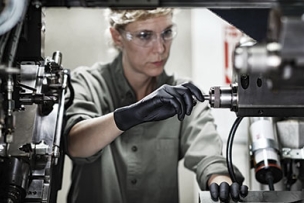High Performance Materials (Primarily for Cut and Abrasion Environments)
High performance materials provide users the greatest protection. There has been a progressive shift to utilizing more seamless knit shells as liners because of their enhanced features.
High performance string knits offer enhanced protection for abrasion, cut, tear, thermal and puncture resistance. The most common, DuPont™ Kevlar and DSM Dyneema®, are covered more in the next section.
Here are four of the most requested high performance materials:
1) DuPont™ Kevlar® withstands temperatures of up to 900° F. Its tensile strength is 5 times stronger than steel in its ability to withstand the amount of tension applied. MCR Safety is a DuPont licensed manufacturer for KEVLAR® brand fiber. MCR Safety is unique in respect to being the only licensed manufacturer which also spins our KEVLAR® yarn.
2) DSM Diamond Tech/Dyneema® is recognized for excellent abrasion and cut protection levels. Additionally, when combined with fiberglass or steel, it achieves higher levels of cut resistance. Dyneema launders well even with the use of bleach. Additional hand protection styles combine HMPE with other materials to offer a highly comfortable fit, often with a palm dip to enhance grip.
Features:
- Provides one of the highest levels of safety with cost-effective protection and comfort.
- World's strongest fiber (15 times tensile strength of steel on an equal weight basis).
- Incredibly tough protection against mechanical hazards combined with an outstanding sensitivity and cost effectiveness.
- Fiber is thinner and more flexible than traditional PPE material while offering higher protection.
- So soft and comfortable to wear, gloves are more likely to be worn.
- Fiber adapts to skin temperature, while transporting moisture to the outside of the glove.
- By providing a higher level of protection, injury costs can be reduced.
- Achieves one of the highest levels of abrasion resistance.
- Highly resistant to chemicals.
- Machine washable and can be reused several times for a longer lifetime.
3) Steelcore® II Two strands of stainless steel wrapped with a soft knit yarn for a comfortable fit.
4) Alycore™ is one of the highest rated ANSI cut and puncture resistant materials available. Alycore™ gloves offer maximum dexterity and sense of touch due to the high degree of flexibility and patent pending construction. All Alycore™ styles provide cut performance levels, which exceed ANSI A9 and CE cut level 5 ratings. All styles are launderable (machine wash, do not dry).








Talk to Us!
Leave a reply
Your email address will not be published. Required fields are marked *